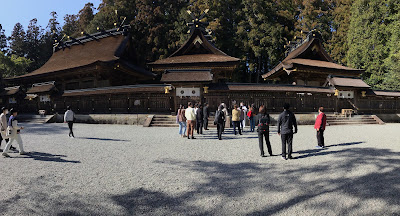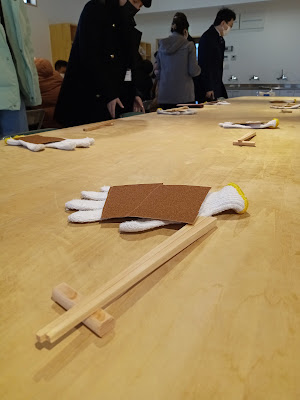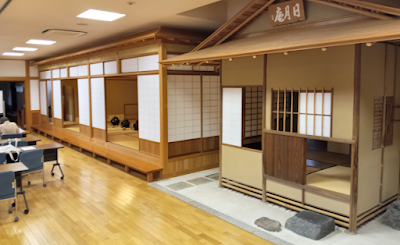Monday brought visits to Nachi Taisha in the morning and Hongu Taisha in the afternoon. This video clip shows the reverse journey from there along route 168 back to Shingu then north to Ise on route 42, all together about 3 hours. A few of the seminar participants remarked how wonderful it is to visit all three in one excursion; and that six months ago none of us would have imagined such a thing. Not so many Japanese are able to do this and even fewer foreign researchers and tourists. Thanks to the great weather, the excellent planning, our experienced driver, and our Shinto professors to help make sense of all the unfamiliar sights, sounds, rituals and words, everyone was able to increase their knowledge and feeling for the traditions of the Kumano San-zan.
The next video clip shows the famous waterfall at Nachi in the surrounding setting of mountains and the buildings and services there, too.
During our reception with the head priest at the Hongu Taisha we learned of the shared as well as different parts of the three Taisha: Hayatama Taisha gives emphasis to connections with the past world, Nachi Taisha with present world commitments, and Hongu Taisha with future directions to strive for. In this way they fit into an entire sweep of time. We also learned of the deep roots of Shinto and Buddhism on the landscape and in the social relationships: Yakushi Nyorai is among the chief kami at Hayatama Taisha, Senju Kannon at Nachi Taisha, and Amida at the Hongu Taisha.
 |
| panorama at Hongu Taisha on Monday afternoon, March 6, 2023 |
The geography (and sacred geography) around the Kumano mountains and rivers has many peaks. And since prominent natural features like peaks, boulders, bodies of water flowing or still, along with prodigious trees can express kami within human spaces, it is easy to imagine the whole horizon filled with kami in every direction. With an abundance of tunnels, bridges, and roads cut into the edges of mountains, though, it is hard to know what the kami think about that. Also hard to imagine is the energy and concentrated efforts of people of this place before internal combustion engines, electricity, and all the tools we enjoy with today's easy transportation and communication.
One illustration of old-time human power is the documented case of transposing the Hongu Taisha from the river where it was destroyed by flooding in August 1889. After 1 year and 8 months, it was fully formed on its new location on high ground and fully operating thanks to local work and outsiders coming to help, too.
 |
| Japan's biggest torii marks Hongu Taisha's place until 8/1889 |





Comments
Post a Comment